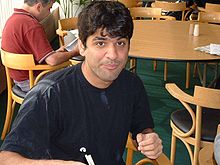Shiraz Minwalla: Difference between revisions
| Line 52: | Line 52: | ||
* Stringy interactions in pp-waves |
* Stringy interactions in pp-waves |
||
* Some insights about [[tachyon condensation]] |
* Some insights about [[tachyon condensation]] |
||
* Dualities in [[supersymmetric gauge theories]], in particular [[Chern-Simons-matter theories |
* Dualities in [[supersymmetric gauge theories]], in particular [[Chern-Simons]]-matter theories |
||
* Fluid-Gravity correspondence, the connections between hydrodynamics and Ads/Cft.(with Sayantani Bhattacharyya) |
* Fluid-Gravity correspondence, the connections between hydrodynamics and Ads/Cft.(with Sayantani Bhattacharyya) |
||
Revision as of 00:22, 19 April 2022
Shiraz Naval Minwalla | |
|---|---|
 Shiraz Minwalla at Harvard University | |
| Born | 2 January 1972 Mumbai, Maharashtra, India |
| Nationality | Indian |
| Alma mater | IIT Kanpur (M.Sc.) Princeton University (Ph.D.) |
| Spouse | Ananya Dasgupta[1][2] |
| Children | 2[1] |
| Awards |
|
| Scientific career | |
| Fields | String Theory, Theoretical Physics |
| Institutions | Tata Institute of Fundamental Research, Harvard University |
| Doctoral advisor | Nathan Seiberg |
| Other academic advisors | Andrew Strominger, Spenta Wadia[1] |
| Doctoral students | Matthew Headrick |
Shiraz Naval Minwalla[1] (born January 2, 1972)[3][4][5] is an Indian theoretical physicist and string theorist.[6] He is a faculty member in the Department of Theoretical Physics at Tata Institute of Fundamental Research, Mumbai.[7] Prior to his present position, Minwalla was a Harvard Junior Fellow and subsequently an assistant professor at Harvard University.[8][9]
Early life
Born in Mumbai, Maharashtra, India, in 1972, to a Parsi-Zoroastrian father (Naval) and a Muslim mother (Khadija), Minwalla graduated from Campion School, Mumbai in 1988 and then Indian Institute of Technology Kanpur in 1995. He later moved to Princeton University to earn his PhD under the guidance of Nathan Seiberg.[1]
Awards
Minwalla was awarded the Swarnajayanti Fellowship 2005-06 by the Department of Science & Technology, Government of India. He was awarded the ICTP Prize in 2010 and the Shanti Swarup Bhatnagar Prize for Science and Technology, the highest science award in India, in the physical sciences category in 2011.[10][3] He was awarded the Infosys Prize 2013 in the field of Physical Sciences by the Infosys Science Foundation.[11][12] Minwalla was awarded the 2014 New Horizons in Physics Prize by the Fundamental Physics Prize for "his pioneering contributions to the study of string theory and quantum field theory; and in particular his work on the connection between the equations of fluid dynamics and Albert Einstein's equations of general relativity."[12][13][14] In 2016, The World Academy of Sciences awarded him the TWAS Prize in Physics.[15]
Notable contributions to the field
- Analysis of primary operators on AdS4 and AdS7
- Three-point functions in N=4 supersymmetric Yang–Mills theory and AdS/CFT
- Noncommutative perturbative dynamics (with Nathan Seiberg and Mark Van Raamsdonk)
- Noncommutative solitons (with Andrew Strominger and Rajesh Gopakumar)
- OM-theory (with Nathan Seiberg, Andrew Strominger and Rajesh Gopakumar)
- Stringy interactions in pp-waves
- Some insights about tachyon condensation
- Dualities in supersymmetric gauge theories, in particular Chern-Simons-matter theories
- Fluid-Gravity correspondence, the connections between hydrodynamics and Ads/Cft.(with Sayantani Bhattacharyya)
Personal life
Shiraz Minwalla lives in Mumbai with his wife and two children.[1]
Selected works
- Bhattacharyya, Sayantani; Hubeny, Veronika E.; Loganayagam, R.; Mandal, Gautam; Minwalla, Shiraz; Morita, Takeshi; Rangamani, Mukund; Reall, Harvey S. (2008). "Local fluid dynamical entropy from gravity". Journal of High Energy Physics. 2008 (6): 055. arXiv:0803.2526. Bibcode:2008JHEP...06..055B. doi:10.1088/1126-6708/2008/06/055.
References
- ^ a b c d e f g "Breakthrough Prize – Fundamental Physics Breakthrough Prize Laureates – Shiraz Naval Minwalla". breakthroughprize.org. Retrieved 29 January 2020.
- ^ Nov 28, Swati Sengupta | TNN |; 2008; Ist, 3:05. "A night of horror | Kolkata News - Times of India". The Times of India. Retrieved 30 January 2020.
{{cite web}}:|last2=has numeric name (help)CS1 maint: numeric names: authors list (link) - ^ a b "Awardee Details: Shanti Swarup Bhatnagar Prize". ssbprize.gov.in. Retrieved 29 January 2020.
- ^ "Indian Academy of Sciences". fellows.ias.ac.in. Retrieved 29 January 2020.
- ^ "Fellowship | Indian Academy of Sciences". www.ias.ac.in. Retrieved 29 January 2020.
- ^ "Physicist makes string theory look simple" (PDF). Tufts Institute of Cosmology. 26 April 2004. Archived from the original (PDF) on 26 June 2010. Retrieved 6 February 2010.
- ^ "Members of the Department of Theoretical Physics". Tata Institute of Fundamental Research. Archived from the original on 14 February 2010. Retrieved 6 February 2010.
- ^ "Sultans of String". The Indian Express. 27 February 2005. Retrieved 6 February 2010.
- ^ "The Telegraph - Calcutta : Metro". The Telegraph. 4 November 2004. Archived from the original on 14 April 2010. Retrieved 6 February 2010.
- ^ "11 scientists selected for Shanti Swarup Bhatnagar award" ibn live, 26 September 2011. "Archived copy". Archived from the original on 4 January 2012. Retrieved 20 December 2011.
{{cite web}}: CS1 maint: archived copy as title (link) - ^ "News18.com: CNN-News18 Breaking News India, Latest News, Current News Headlines". News18. Archived from the original on 8 December 2013. Retrieved 27 April 2018.
- ^ a b Vasudevan Mukunth (14 November 2013). "'Research in India happens in a few elite institutions'". The Hindu. Archived from the original on 17 November 2013. Retrieved 14 November 2013.
- ^ "Archived copy". Archived from the original on 10 November 2013. Retrieved 14 November 2013.
{{cite web}}: CS1 maint: archived copy as title (link) - ^ "NEWS - ICTS". www.icts.res.in. Archived from the original on 1 January 2017. Retrieved 27 April 2018.
- ^ "Prizes and Awards". The World Academy of Sciences. 2016. Archived from the original on 1 January 2017.
